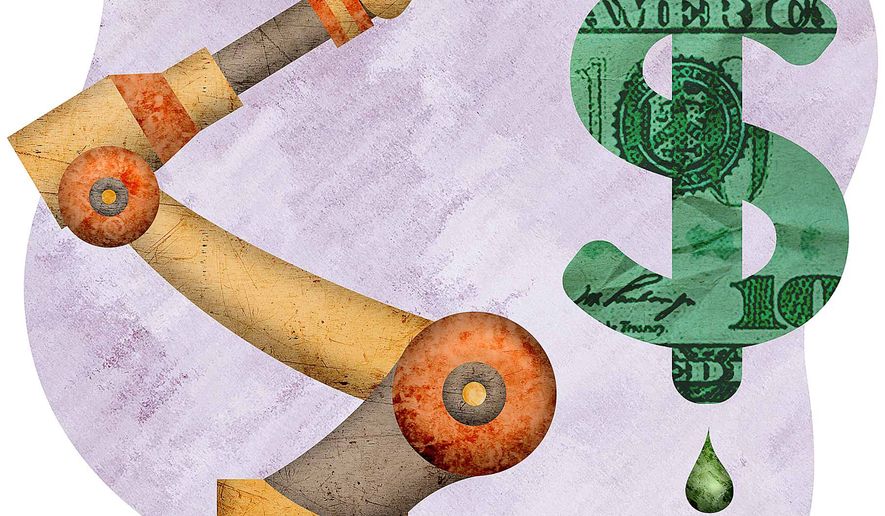OPINION:
In January, Wall Street investors were optimistic tax cuts would sustain economic growth and the Trump bull market. As spring arrives, the world has proven decidedly more uncertain.
The administration has not articulated end game goals for the trade standoff with China. President Xi Jinping is offering some concessions but his commitment to industrial policies that target vital American industries remains clear and menacing. An all-out trade war could disrupt global supply chains, nix planned investment spending, stall both economies and tank stocks.
The Facebook imbroglio raises prospects of tighter regulations on the tech sector, and the kind of Washington overreach that gave us Dodd-Frank, which crippled regional bank lending and substantially slowed the Obama recovery.
Along with President Trump’s vitriolic remarks about Amazon, those combined to take the stock market well off its January highs. And now Federal Reserve Chairman Jerome Powell could face the tough choice of easing back on planned interest rate hikes to keep the economy growing or accelerating those to keep inflation from flying out of control but pushing America into a recession.
The March jobs report indicates businesses continue to hire at a nice clip — the three-month average is 202,000 and wages were up only 2.7 percent on a year over year basis. Along with productivity growth at its recent pace of about 1 percent a year, that should keep inflation right in line with the Fed’s 2 percent target.
Indeed, core inflation — prices less the volatile food and energy sectors — has been hovering at just about that pace.
This wage and price performance puzzles economists. Unemployment at 4.1 percent is quite low, and even in the interior in places hard hit by globalization — for example, Indiana, Iowa and Nebraska — economic development officials report businesses scurrying to find workers.
This is hardly new — we have heard reports of worker and skill shortages for many months — but those hardly seem to show up in the wage or consumer price inflation statistics.
During the recent recovery, four factors have kept inflation in check — the revolutions in shale oil and advanced recovery technics, non-oil commodity prices depressed by excess capacity from the overhang of the Great Recession, expanded competition from inexpensive imported manufactures and increased retail competition enabled by Internet commerce — but those mostly have run their course.
Investors are pushing smaller U.S. oil producers to finally turn profits and domestic oil prices are up, broader import prices are now rising at a 3.6 percent annual clip and stronger global growth has pushed up costs for critical items like building materials.
The housing sector is particularly squeezed. The combination of tighter building codes, higher material prices and shortages of essential skilled workers keep new home construction below pre-recession levels and are boosting new home and resale prices.
Amazon and other Internet retailers have eliminated many of the weaker brick and mortar competitors, and now must squeeze better margins out of their supply chains or expand into other activities to grow. For example, Amazon is both raising prices and expanding into package delivery, drones, ocean freight and a host of other activities.
Stronger productivity growth could mitigate all these pressures on inflation.
White House economists are confident that deregulation, business investment prodded by tax cuts and deregulation will restore the lost era of strong productivity gains — those averaged 2.3 percent a year from 1947 to 2009.
Economists mostly sort into two camps — those who believe the post-World War II period was exceptional and those at the White House and a few others (count me in) who believe the best is yet to come — that artificial intelligence and robotics is about to break loose progress on the scale of the Industrial Revolution.
That’s why the former see tax cuts as primarily demand stimulus and after a brief period of stronger growth, the economy slowing to a pace in line with the Obama recovery. In contrast, the White House and a few others see growth speeding up to about 3 percent longer term.
We can’t wholly relive the Reagan-Clinton decades, because of slower adult population growth and the effects of expanded entitlements on labor-force participation among prime-working-age adults.
However, if the optimists are right about productivity, the Trump economy will be saved and the Fed will have a lot easier time than many expect.
• Peter Morici is an economist and business professor at the University of Maryland, and a national columnist.




Please read our comment policy before commenting.